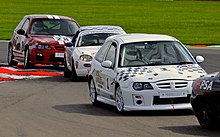MG ZR
Compared to the Rover 25, the ZR featured a number of styling modifications and performance enhancements, such as updated sports suspension and a less baffled exhaust.
Tens of thousands of MG ZRs were sold in Britain and proved particularly popular with young buyers who were attracted by deals such as free insurance and discounts that were the equivalent of VAT.
This had a more advanced brake set up despite the small power increase, featuring the same diameter 262mm discs up front, but this time vented for better cooling.
The other diesel engined ZR was the TD 115 which came with the same 2.0 L series engine but with some minor performance enhancements (improved ECU map), to produce 111 bhp (83 kW; 113 PS) and 260 N⋅m (192 lbf⋅ft) of torque, which gave the car a 0–60 mph time of 9.1 seconds and a top speed of 116 mph (187 km/h).
The 2004 model also received a revised interior with new seat materials and a new dashboard design incorporating soft touch buttons.
MG Sport & Racing signed Gwyndaf Evans, Tony Jardine and Natalie Barratt to compete in a number of events.
After only two events, and due to poor grids, the 'Team Airconstruct' cars were modified with dry break refueling systems and entered into the EERC Britcar Endurance Series run by James Tucker.
John Hammersley with son Mark took the Series win in the following year with the car, which had by then been upgraded to 'works' specification 190 bhp (142 kW; 193 PS), Group N+ Spec.
In 2016, the MG3 received many improvements: the installation of an EU 6 derivative of the standard 1.5-litre engine developed by SAIC Motor UK, a start-stop system was fitted, and two-tone colour schemes, primarily on the red and yellow MG3's which can have either a black or white roof, were offered as options.




